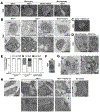Hiding in plain sight - platelets, the silent carriers of HIV-1
- PMID: 33222575
- PMCID: PMC8141065
- DOI: 10.1080/09537104.2020.1849606
Hiding in plain sight - platelets, the silent carriers of HIV-1
Abstract
There are approximately 38 million people globally living with Human immunodeficiency virus 1 (HIV-1) and given the tremendous success of combination antiretroviral therapy (cART) this has dramatically reduced mortality and morbidity with prevention benefits. However, HIV-1 persists during cART within the human body and re-appears upon cART interruption. This HIV-1 reservoir remains a barrier to cure with cellular sites of viral persistence not fully understood. In this study we provide evidence corroborating a recently published article in STM demonstrating the role of platelets as a novel cellular disseminator of HIV-1 particles in the setting of viral suppression. Using classical transmission electron microscopy with and without immunogold labeling, we visualize HIV-1 in both platelets and monocytes in cART suppressed HIV donors. Our study suggests that due to the close proximity of platelets and monocytes an alternative life cycle of HIV-1 cycling within monocytes and platelets without the need of active replication under cART occurs. Our findings are supported by the lack of detectable HIV-1 particles in platelets derived from HIV uninfected donors or the 'Berlin' patient suggesting that platelets may serve as an underappreciated hidden bearer for HIV-1 and should be considered in HIV remission studies and trials.
Keywords: HIV-1; HIV-1 persistence; HIV-1 reservoir; monocytes; platelets.
Conflict of interest statement
Disclosure of interest
All authors read and approved the submission of the manuscript. LCN has received honorarium for participating in advisory meetings for Abbvie. All other authors report no potential conflicts of interest. The Social Determinants of Obesity and Cardiovascular Risk Laboratory is funded by Division of Intramural Research of the National Heart, Lung, and Blood Institute and Intramural Research Program of the National Institute on Minority Health and Health Disparities. Core facilities were supported by NIH grants P20GM103516, P20RR016453, G12RR003061, and G12MD007601. The Hitachi HT7700 TEM was acquired with NSF grant DBI-1040548. This project was also funded in part by the National Institute of Mental Health (award R01MH104141) to LCN.
Figures


References
-
- Deng K, Siliciano RF. HIV: Early treatment may not be early enough. Nature 2014;512:35–36. - PubMed
-
- Real F, Capron C, Sennepin A, Arrigucci R, Zhu A, Sannier G, Zheng J, Xu L, Masse JM, Greffe S, et al. Platelets from HIV-infected individuals on antiretroviral drug therapy with poor CD4(+) T cell recovery can harbor replication-competent HIV despite viral suppression. Sci Transl Med 2020;12. Epub 2020/03/20. - PubMed
-
- Baumer Y, Gutierrez-Huerta CA, Saxena A, Dagur PK, Langerman SD, Tamura K, Ceasar JN, Andrews MR, Mitchell V, Collins BS, et al. Immune cell phenotyping in low blood volumes for assessment of cardiovascular disease risk, development, and progression: a pilot study. J Transl Med 2020;18:29. Epub 2020/01/19. - PMC - PubMed
MeSH terms
Grants and funding
LinkOut - more resources
Full Text Sources
Other Literature Sources
Medical
